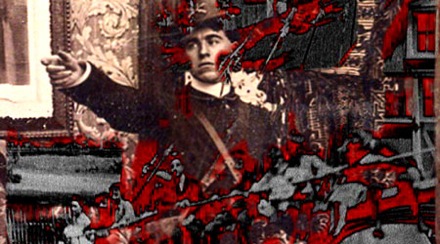Tribeca Movie Review: RAZZLE DAZZLE The Lost World
The following film was screened at the 2007 Tribeca Film Festival.

Razzle Dazzle
Spotlight, Narrative
2007, U.S.A.
Dir: Ken Jacobs
With his new installment, noted experimental filmmaker Ken Jacobs aims to distort his images to such extreme length, as to reconceptualize them and give them a whole new meaning. The tool of choice for him is repetition, repetition, repetition. Jacobs takes what seems like the ordinary, the sublime, the mundane, and turns it into something altogether haunting. Akin to other fringe filmmakers such as Hollis Frampton, Bruce Baillie, and Chris Marker, the work of Jacobs has influenced the likes of Harmony Korine, and to a lesser degree, Michel Gondry. His various works, including Tom, Tom, the Piper's Son (1969) and Star Spangled to Death (2004), are considered important pieces within the world of avant-garde cinema.
In Razzle Dazzle, Jacobs appropriates an early film by Thomas Edison from 1933, and manipulates it to such an extent that it creates a truly other worldly feeling. He takes this short, one shot sequence of a large group of children riding on an amusement ride of that era, and just tears it to pieces digitally, giving it a whole different life of its own. He slows it down, superimposes it on multiple images of itself, substitutes the white background with an eerie red that spills all over, and magnifies it to such a degree that images are no longer conventionally recognizable. With the freeze-framing of the film, we come to make out the ghastly faces of the children, with the red embers ablaze behind them.
Jacobs also employs stereopticon slides from the same era as the short film, edited in such a way that the figures in the pictures seem to be moving in a 3D-like fashion. The slides are positioned in between the fractured images of the amusement ride, creating an even more ominous tone to the film. At one point, a segment of prose appears on the screen alongside a slide of a crashing wave. The words describe a certain wave that holds immense pride in itself, and that regards itself as all-powerful and unbeatable. However, the wave comes across the rocks and slams into them, being stopped dead in its tracks.
The words and images lead to one to believe that Jacobs is commenting on modernity, and to a certain point, critiquing it. We see in the original Edison film, from 1933, a group of people fascinated with a new machine. The Industrial Age was in full bloom and the drive to progress with each and every new advancement was palpable. Jacobs decides to take this film and, using it as his own canvas, deconstructs it in a way that makes the children look like ghouls, burning among the fire because of their naivety and innocence in the age they were living in. Their obsession is their downfall. In a way, one can see parallels to this and the world we live in today; a world so obsessed with each and every technological advance that perhaps it can't see the dangers that lie ahead. And it is this very notion that gives importance and credence to Jacobs work, as it surpasses mere abstraction and dares to go beyond.
A bit too long for a film of this sort, but incredibly insightful and mind-bending. Only for the most brave and risk-taking of filmgoers.
/Film Rating: 8 out of 10